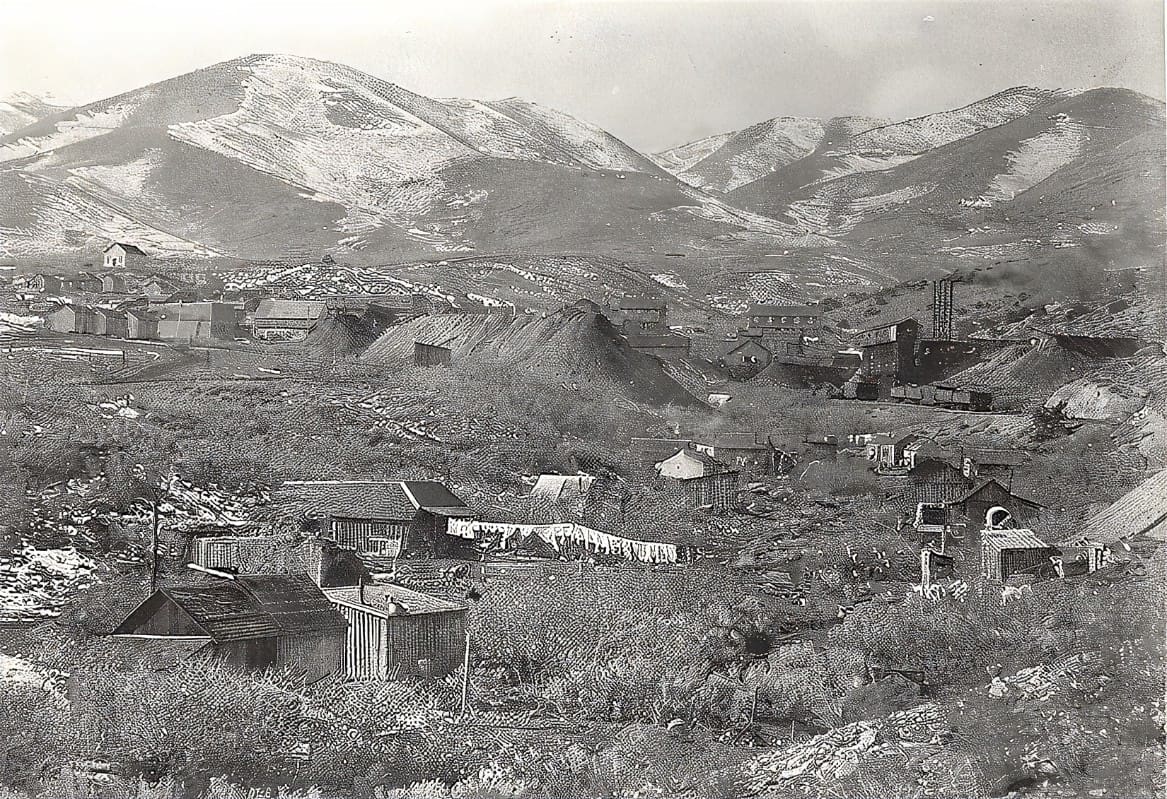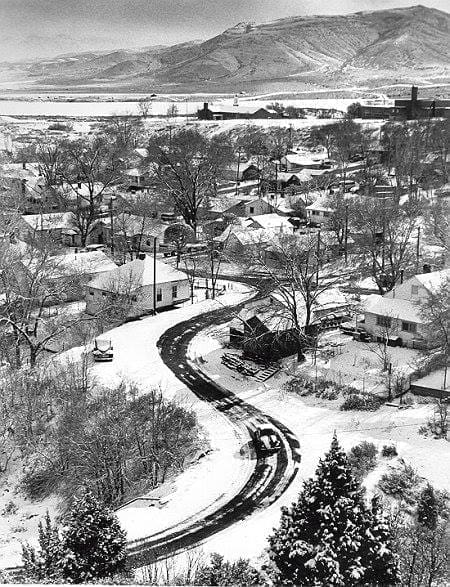I come from miners’ stock. My grandfather and great-grandfather on my mother’s side were hard rock miners. And when they were not working in the mine, they were driving a team of horses. They both worked at a mine that supported a town that is now dead. The town no longer exists. The land was purchased by a bigger mine and then the town was closed down.
My grandfather’s name is Frederick A Farhni (1907-1990), and my great grandfather’s name is Gottfried (Fred) Fahrni (1855-1940). Both of these men were miners in a small town called Lark, Utah and they mined the Lark Mine.
Lark, Utah
Lark, Utah is no longer. It was a small town of 800 at its peak north of where Eagle Mountain currently is and shared the Qquirrh mountains as well. It is now partially covered by the tailings of the Kennecott Mine. The town was founded officially on January 3, 1866, after the discovery of gold in the Bingham Canyon. The last silver, zinc, and lead mine in the area closed in 1971. In 1972 Kennecott Copper bought the land, and in 1977, they announced foreclosure. The town was then dismantled and Kennecott helped move the residents. They prepared a subdivision in the town of Copperton for them to move to if they wished.
The Reunion
The reason I am writing this article is that my Mom (now 81) and I went to a Lark reunion. I am the type of person that likes to sit back, and listen to other people talk, at least in situations like this. So that is exactly what I did. The majority of the people at the reunion were those that lived in Lark after my mother got married and left Lark in August of 1965, and after the mines had closed. I was born in 1970, and only have memories of after the mines closed. My grandfather Fred was retired from the mines.
I sat at the reunion and listened to the stories, and realized that there was a huge piece of Lark’s history that was missing. The generation that lived in Lark during the operation of the mine were few. Now that mining has changed so vastly, there are no longer small mining towns scattering the area. Towns like Ophir, Mercur, and Lark use to dot the Oquirrh mountains. They are now ghost towns or like Lark have been completely removed. And as the people who lived in those towns grow old and return to the dust, their legacy dies with them. In the case of Lark, you can’t just drive to Lark and walk down the ghost town streets or see the ghost town-style buildings. All the buildings are gone, the mines have been filled in, and the tailings from Kennecott slowly engulf the main street.
With the death of that old mining generation, we also see the death of very hard-working, rough, and hardy people. Their stories, their experiences, and their mark on life, in some cases, have been completely erased, and have been relegated to a few sentences on Wikipedia or the writings on a blog and a slowly disappearing reference on a map.
Here are a few of the stories that I heard while listening to the old timers talk.
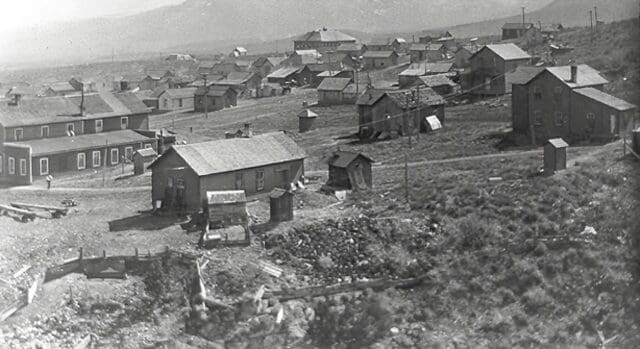
Snow Days
The children of Lark would love snow days. Snow meant that their teacher could not travel from the city she lived in. It meant sledding down the streets of Lark. My mom Lois Fahrni (now Kieffer) would tell me of the time the girls would go get their brooms, the boys would take all of the town’s discarded Christmas trees, and they would make the life of the snow plow drivers very difficult. First, they would take the trees and block off the roads they wanted to seld on. Then snow plow drivers would have to get out of their trucks and move the trees. While that was happening word would spread quickly around the town. Then the girls of the town would show up with their brooms. As the snow plow would drive up the street laying down ash to melt the snow the girls would sweep it aside to protect the sledding path.
Water Tower
Lark had a water tower where most of the residents would get their water. I found out while listing that it was not uncommon for the boys to show their moxie and using a rope ladder they would climb up to the water tower and swim in it. I am sure if the parents knew about what was happening, they would probably boil their water.
Fools Gold
Every summer I would go spend several days with my grandparents in Lark. Zelma would always bake cakes and great food. I don’t think she ever cooked from a box. We would often leave in the early morning and go hunt for treasures in the tailings left by the mines around Lark. We would find some pretty serious fools gold clusters at times. We eventually would get hungry, and then return home for a short lunch, and then off we were exploring again. Nowadays parents would never allow their kids to do what we did when we were young. I even had one person say they were surprised we did not return glowing green.
Lark is no longer
Oral Interview With Residents
These were collected prior to the residents leaving Lark.
Utah State University MSS COLL 339 Box 1 Folder 7.
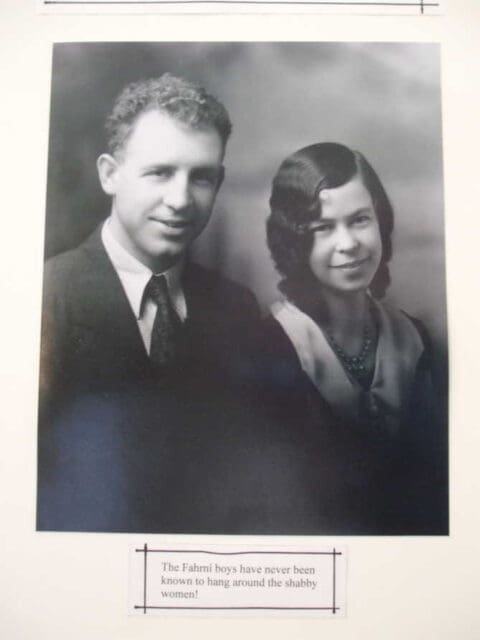
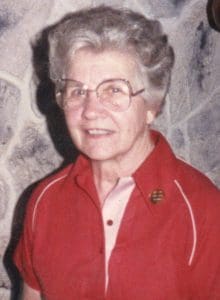
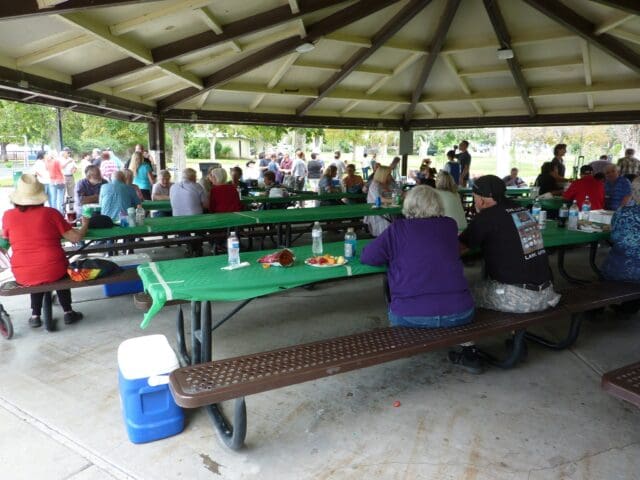
These stories are a few of the stories that you can find on the internet if you search for them. The reunion was a success, but I still felt as I left that a legacy was slowly dying. That in the next few years the mining history and stories of Lark would be told by those who have never seen the mines or worked in them. Let’s pause for a moment and remember those who made our lives possible, and paved the way so that we can call Utah home. These are the people that made Eagle Mountain and the Cedar Valley possible. The original Oquirrh mountain residents.
Mike Kieffer is an IT geek by hobby and trade, with a BS in Information Systems & Technology. He is a proud father of 10, a grandpa, an author, a journalist, and internet publisher. His motto is to “Elevate, Inspire and Inform”, and he is politically conservative and a Christian. Mike has a passion for technology, writing, and helping others. With a wealth of experience, he is committed to sharing his knowledge with others to help them reach their full potential. He is known for his jackassery or his form of self-expression that encourages boldness, creativity, and risk-taking. It can be a way to push the boundaries and challenge traditional norms, leading to creative solutions and positive change.
